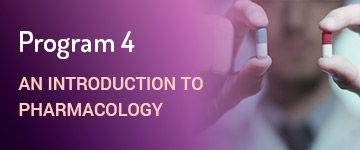UMORE - Pharmacy
Program 4
Program 4: An Introduction to Pharmacology

Program 4 explores how drugs interact with and alter the chemistry of the body, supporting learning through discovery-based interactive activities and real-life applications. The program looks into how drugs are administered, absorbed, transported through the body, and removed.
Program 4 is comprised of 6 modules and is estimated to take approximately 26 hours to complete.
Intended Learning Outcomes
- Describe chemical and physical properties of drugs and how these chemical features influence their mechanism of action
- Describe the fundamental concepts of drug-receptor interactions
- Explain the biological pathways of absorption, distribution, metabolism and excretion of drugs, and factors that influence these processes
- Explain the concept of bioequivalence and biosimilar drugs
- Explain factors affecting dose-response relationships and response variability
- Classify and describe different types of unwanted drug effects
- Describe how drug formulations and route of administration influences drug delivery
Module contents
This module introduces foundational principles of pharmacology and its two main areas: pharmacokinetics and pharmacodynamics. We investigate what a drug is and its role in therapeutics.
This module outlines the various means by which drugs can enter cells to elicit a therapeutic effect. To reach the target cells, many drugs need to move across layers of cells (tissues) which make up the biological barriers of the body. We investigate the effect that physicochemical properties such as lipophilicity, solubility, degree of acidity, molecular size, shape and isomerism have on drug movement through the body.
In pharmacodynamics, we investigate how a drug can act non-specifically and specifically on receptor sites to elicit a physiological effect. We compare these effects in terms of drug potency, efficacy and safety. We review the body’s immune response through vaccination and immunotherapy before exploring innovations in monoclonal antibodies, gene therapy and personalised medicine.
We will discuss in detail the process of drug absorption into the body by various means and the factors which influence the amount of drug reaching the bloodstream. We will also discuss how a drug is distributed to the tissues in the body and reach the site of action. We will then explore how the drug is removed from the body. Finally, we pharmacologically compare bioequivalent and biosimilar drugs to innovator products.
This module examines the physiological, psychological and pathological patient-related factors that can affect a person’s response to a drug. A person’s response to a drug can result in unintended effects and we outline the various categories of adverse drug reactions that may occur. We look into drug-related factors including drug interactions, time of administration, route of administration and dosage forms that can affect the action of a drug and dosage amount.
For more information on this or other UMORE courses, and to enrol, sign up to our iLearn website.
